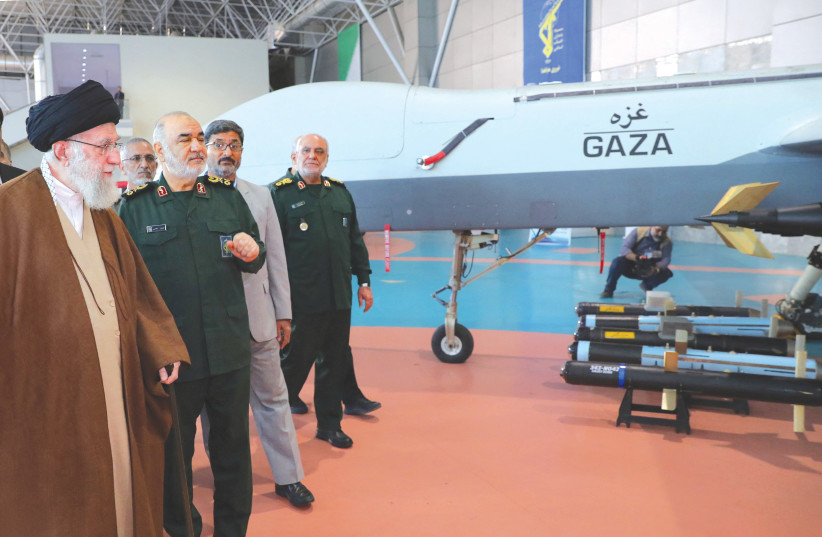In the days after an airstrike in Damascus led Iran to vow to “punish” Israel, many people in the region are wondering what may come next. While it’s possible Iran may seek to use ballistic missiles to target Israel – the way it targeted Al-Asad Airbase in Iraq in 2020 after the US killed IRGC Quds Force commander Qasem Soleimani – people in the region fear other types of escalation.
Iran has often preferred to escalate attacks in other countries, using proxies in past years, whenever there are tensions with Israel, the US, or other countries. For instance, Tehran prodded the Houthis in Yemen in the past to attack Saudi Arabia and the UAE.
Tehran often prefers to get others to do its dirty work, although that’s not always the case. In addition to the 2020 attack on Al-Asad Airbase, where US forces were present, Iran also directly attacked Saudi Arabia in the September 2019 attack on the Abqaiq energy facility. In that attack, Iran used drones and cruise missiles.
Iran’s capabilities in this respect are well known. It has a large number of long-range ballistic missiles. In January, Iran carried out attacks on Pakistan and Syria using rockets. Tehran claimed it used a long-range missile attack on ISIS in northwest Syria. It used its Kheibar Shekan ballistic missiles. The attack was a “message” for the US and Israel, according to Iranian media at the time.

Typical Iranian response: show off capabilities
This is the typical type of Iranian response: showing off capabilities or striking at others. Iran also bases its missiles and drones in other countries. For instance, in late 2020, Iran moved its Shahed 136 drones to Yemen, according to reports. They were spotted in aerial photos in early 2021, according to Newsweek.
The same drones were then exported to Russia for use against Ukraine. The drones have a range of about 2,000 km. They carry a warhead and fly a one-way kamikaze mission. Iran moved drone and missile technology to Yemen over the last decade. This enabled the Houthis to strike at Riyadh and more recently to attack ships in the Red Sea.
Tehran also has moved drones and missiles to Iraq. Beginning around 2018, Iranian ballistic missiles were said to have moved to Iraqi areas and were secured by Iranian-backed militias. Iran did this once ISIS was defeated in Anbar province.
Then, Tehran helped build the Imam Ali base near Albukamal, Syria, on the Iraqi border. This enabled Iran to warehouse munitions and move weapons to Hezbollah in Lebanon. Tehran likely was at least in part behind the decision by Hezbollah in 2019 to try to post a unit, using what was described in media as “killer drones,” near the Golan.
Iran also moved drones to the T-4 base in Syria, and in 2018, it targeted Israel with one of these drones. In the 2021 conflict with Hamas in Gaza, Tehran prodded a militia in Iraq to target Israel with drones. The IDF used F-35s to intercept two Iranian drones in March 2021.
While Iran has been moving drones and missiles to proxies in the region over the last decade, it has also increasingly targeted other groups when it wants to “respond” to Israel. For instance, Rudaw media in Erbil reported in mid-January: “Iran’s Islamic Revolutionary Guard Corps claimed responsibility for a massive ballistic-missile attack on the Kurdistan Region’s capital of Erbil that killed at least four civilians, claiming to have hit ‘spy headquarters’ of anti-Iran groups in the Region.”
IRGC-affiliated Tasnim News Agency said in “response to the recent terrorist crimes of the enemies of the Islamic Republic of Iran, the spy headquarters and gatherings of anti-Iran groups in parts of the region were targeted by IRGC ballistic missiles in the middle of the night,” the report said.
Five ballistic missiles were fired at Erbil, the capital of the autonomous Kurdistan Region in Iraq. At least four civilians were killed and 17 wounded as the missiles struck, Rudaw reported, adding that Kurdish businessman Peshraw Dizayee was dead.
In March 2022, Iran targeted another businessman in the Kurdistan Region. It attacked a mansion owned by Baz Karim Barzinji, CEO of the Iraqi Kurdish oil company KAR Group. The IRGC said it had fired 12 missiles at his house.
Iran’s tendency to lash out at Kurds is now leading to concerns in the region. The Kurdistan Region in northern Iraq is close to US bases and hosts US forces. In addition, the US backs the Syrian Democratic Forces in Syria, a group that includes Kurdish anti-ISIS fighters. As such, Iran often targets these two Kurdish areas because it is easier to target them since they are closer to Iran and closer to Tehran’s proxies in Syria and Iraq.
Iran has a history of using proxies to attack others so that after the attack, Tehran can claim it has no responsibility for the attack.
Today, as the region awaits Iran’s claims that it will “punish” Israel, many countries and groups are wondering if they will be on the receiving end of the Iranian response, whether directly or by proxy.
